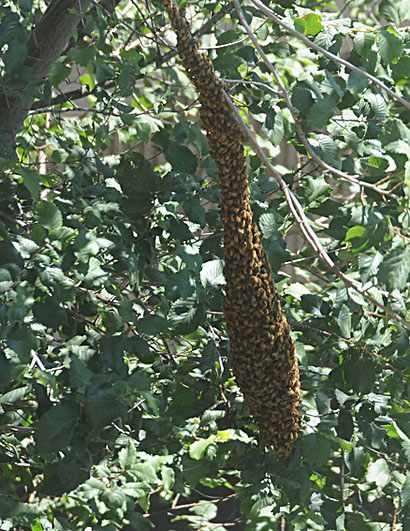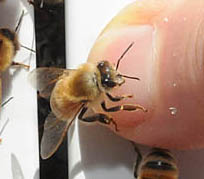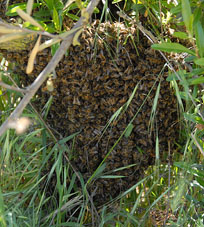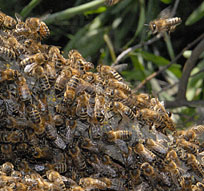
Bee swarm on tree outside Briggs Hall, UC Davis campus. (Photos by Kathy Keatley Garvey)
Swarms
Removing Swarms and Established Colonies from Private Property
By Eric C Mussen, Extension Apiculturist, UC Davis
What is a swarm?
Swarming is the honey bee’s method of colony reproduction. The old queen and half of the worker bees leave their former nest and seek a new home mostly in the spring, but sometimes
in late summer. A few worker honey bees, we call “scouts,” fly around areas in the vicinity of the old hive searching for a suitable, new habitat (the correct sized cavity with an easily protected entrance). Often, that job is not completed when the swarm “issues” from the hive.
The outpouring of bees from the hive forms a large, buzzing cloud of insects that seems to be going every direction at once. That flying group of honey bees is the swarm. It is a phenomenal sight that frequently scares people. However, the bees eventually have to regroup, somewhere, while the search for a new home continues.
What do swarms do?
A few other worker bees, called “leader bees,” fly from the hive to a distant location, then land and secrete Nasanov pheromone. That lemon-like odor is attractive to the bees and queen in the swarm. The bees coalesce into a single group, on an object. The group properly is called a “cluster,” but most people still refer to it as a swarm. The bees in the cluster are carrying honey from the old hive and are much less defensive than they would be if they still were protecting combs containing brood (immature bees) and stored foods (pollens and honey). At this point in time homeowners attempt to reach someone to take the bees away. In the spring, this makes sense to a beekeeper, because the bees have all summer to build their population and collect enough honey to survive the winter. Fall swarms will not have a full season to collect stores and beekeepers often are not too interested in collecting them. During the time that scout bees are seeking a new nesting site, foragers fly to and from the cluster collecting mostly nectar (dilute sugar syrup) to keep their cluster mates hydrated and energized. If the scouts do not find a new location for the swarms to live, the urge to build comb can become overwhelming and the bees will build an “exposed comb colony,” suspended from a tree limb, the overhang of a house, or so other unusual place.
How are swarms removed?
Experienced beekeepers often remove clusters simply by brushing the bees gently into a box and taking them away. This is best done after flight activity has ceased for the night, since the scouts and foragers will be back on the cluster. The beekeeper should be prepared for defensive behavior, in case it develops, but dealing with a cluster is usually quite easy. This changes, however, as the cluster becomes more difficult to reach, such as way up in a tall tree, intermeshed with the branches of a shrub, or wedged into the corner of a building. It is best to supply the beekeeper with as much information as possible about the swarm to prevent surprises. Regulatory agencies and professional pest control operators probably will have no desire to “take them alive.” So, chemicals will be used to kill the bees in the cluster. Choice of chemicals varies from commercial formulations of “soapy” water that prevent flight and drown the bees, to quickly toxic materials that simply knock out the bees’ nervous system and kill them. Regardless of the material used, the dead bee bodies should be collected and disposed of properly to prevent poisoning of birds or mammals that might ingest the contaminated carcasses. A stomach full of soap or detergent is just as lethal as a stomach full of synthesized pesticide,
What if the swarm is moving into my house?
 |
| Swarming bees on hand. Click to enlarge. |
Sometimes it is difficult to determine whether a honey bee cluster on the side of a building is simply resting there or moving, one by one, through a hole into an inner portion of a building. If the cluster size is shrinking, but hasn’t flown away, chances are they are moving in. Obviously, when they first arrive, they are short on food and have to build combs from wax they produce from the honey they are carrying. If they are not allowed to continue foraging for nectar, they will not accomplish much building. At this point in time, they can be “locked in” their new home with screen, steel wool, or something else through which they cannot chew to escape. They will die in place over the next week or two. However, they will be roaming around the area trying to find a new entrance, and a number of them are likely to find their way into the living quarters, especially by following beams of nighttime room lighting. Bees do not fly in the dark, but they will fly to the windows the next morning and stay there most of the day while they die of dehydration. They can be sucked up safely with a vacuum cleaner hose. Remember there may be live bees in the bag for a couple days after they have been vacuumed up.
What if bees have been established in my house for a while?
Once the bees have become established, they will have built one or more combs in which they are rearing brood and storing food. Often they do no structural harm to the building, but they are noticeable by their incessant “humming.” That is the sound of the bees ventilating their hive with fresh air and blowing out carbon dioxide, if it accumulates. The sound picks up in intensity when ventilation also is being used to evaporate water from nectar to change it into honey. Occasionally, the bees use water to soften sheetrock and remove it in order to expand the nesting area. Residents then will notice an enlarging “damp” area on the wall. In a few cases, the bees actually open a hole through the sheetrock. Very few people will respond to that event as did the person who opened the hole wider and covered it with a sheet of glass to have his own “observation hive.”
How are established honey bee colonies removed?
 |
| Swarming bees at Laidlaw facility. Click to enlarge. |
Regardless of whether the bees are removed alive or dead, the combs have to be removed from the building. If they are not removed, the stored honey eventually will absorb enough water to allow yeast spores to germinate and ferment the honey. The resultant gas bursts the cappings and allows the honey to drain from the combs. Gravity starts moving the honey, then the first horizontal obstruction usually brings the honey into the home: a ceiling, a fire-break two by four, a window frame, a door frame, the floor, etc. The damage will be expensive to repair. Bees killed by pesticides may drop into a pile, where their bodies do not dehydrate quickly enough. Microbes growing in the bodies of dead bees can produce very offensive odors. Since it is not a good idea to handle pesticide contaminated honeycomb, anyway, it probably is best to eliminate the bees without first killing them by opening a hole in an exterior or interior wall, ceiling, etc., that is large enough to reach in and get the combs out. It is wise to consult with a contractor before the hole is opened. Some holes close a lot easier than others. If the bees are to be saved, the bees and combs are taken out gently and placed in a box or some other suitable container. With less regard for the bees’ safety, they can be removed from the void with a vacuum device (shop vac). This process tends to stimulate the bees to release “alarm pheromone” (smells like bananas) that increases defensive behavior, so everyone nearby must be fully clothed in a “bee suit.” Many beekeepers have baffles and collection containers, in their vacuum lines, to try to protect and save the bees. If the homeowner has a lot of patience, the bees can be “trapped” out of the building using a one-way wire screen devise that forces bees that leave the building to relocate into a beehive placed adjacent to the original entrance. Consult with your county agent (Farm Advisor in California) to be directed to a bee specialist who can help describe this procedure.
What do I do after the bees are gone?
 |
| Swarming bees at Laidlaw facility. Click to enlarge. |
Once the bees and combs are removed from the building, there will be traces of beeswax left behind. Honey bees have an extremely acute sense of smell and the next swarm will be attracted to the site where the combs used to be. Therefore, it is mandatory that all holes or openings of one-quarter inch or larger be caulked, screened, or otherwise plugged to keep the bees out. Bees do not chew their way into buildings, but they are experts at finding a hole to get through. The area requiring examination and servicing includes the whole side of the building around the previous entrance or both sides of the building, if the entrance was on a corner. Some people fill the void where the previous nest was located with expanding foam insulation. But, if the bees can find access to a void adjacent to the previous nesting site, they will move right in. During the extraction process some bees are likely to escape. Also, some honey bee foragers spend the night away from the hive in the summer. So, there is likely to be a cluster of bees forming around the entrance after the bees and combs have been removed. That small number of bees can be vacuumed up or eliminated with an aerosol spray labeled for use on wasps and bees outside the home. Be sure to read the label and follow the instructions strictly.
Where do I find beekeepers?
The best bet for finding beekeepers who are interested in picking up swarms or extracting bees from buildings is to look in the Yellow Pages under Beekeeper or Beekeeping. If someone is listed, be sure to ask how much it will cost to have the bees removed. You may wish to shop around to compare prices, especially in areas known to have Africanized honey bees. If no names are listed under the suggested headings, in California try contacting the office of the County Agricultural Commissioner listed in the county white pages at the beginning of the telephone directory. In some California urban counties, the title for that office will be the Sealer of Weights and Measures.